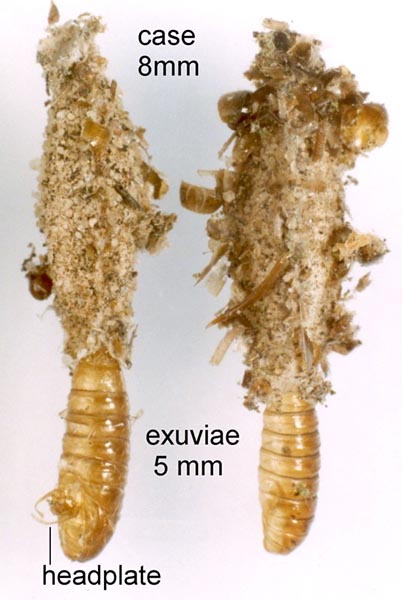11.003 BF176
Dahlica triquetrella
(Hübner, [1813])
Description by Ian F. Smith:
Though winged males occur in Europe, only the parthenogenetic wingless female form of Dahlica triquetrella has been recorded in Britain; with confirmed records from Kent, Westmorland and Essex, but it may have been overlooked.
In mainland Europe, its preferred habitat is on algae covered bark of trees on the edges of woods with a southern aspect, but it is also found on algae or lichen on rocks, stones, posts and house walls, and in meadows on moss. The diet of algae and lichen has to be supplemented by dead insects for development to be successful. The adult lives a very short time, so the cased larva or pupa are more likely to be found.
- More Details:
The silk case, triangular in cross section and tapered at both ends, is covered in sand, frass and bits of dead insect. The larva overwinters fully fed in a rock crevice or crack in tree bark, sometimes near the ground. The larva is active as the snow melts in Europe, the date depending on altitude (up to 2200m), February in Britain, at temperatures of 1 or 2 degrees Celsius.
After selecting a suitable site and sewing the front of the case shut, the larva pupates in the case. In March or April the pupa extrudes from the case for the wingless female to emerge and lay her eggs in the vacated case. It appears that parasitised larvae are the first to move to pupation positions. At one Swiss site, 99% of early larvae were affected; two weeks later, none were parasitised.
Positive identification depends on dissection of the genitalia, or examination of the headplate of the pupal exuviae.
Larva:
Food: Lichen and algae on tree trunks, rocks, posts and stone walls in sunny situations. Supplemented by dead insects. April to February.
Late instar (Description based on 'Schmetterlinge und ihre Lebensräume' Band 2, by Schweizerischer Bund für Naturschutz. It notes that larvae of the species in the genus Dahlica are very similar.)
Head: Brown.
Thorax: Strongly sclerotised, brown.
Thoracic legs: Brown.
Body: Pale yellow. Final instar case 8mm to 10 mm, sometimes only 6 mm, distinctly triangular cross section, tapered both ends, faces flat or slightly depressed. Silk covered in sand (grain size 0.3mm -1 mm) and bits of dead insect. Pupal exuviae extruded from end.Similar species: There has been much confusion with the identification of Dahlica spp. The author of this text may be able to pass on larval/pupal cases, preferably with exuviae and headplate, to an experienced worker for confirmation. The pupal headplate, often found displaced but still attached to the pupal exuviae, is a useful diagnostic feature. However, care should be taken, as the individual elements are rarely disposed in exactly the same positions after emergence. The angle of view can also cause variation.
176 Dahlica triquetrella: Only wingless females in Britain. (Males occur at some mainland Europe sites). Case has fragments of insect attached. (Beware insect fragments on 180 Diplodoma herminata and anterior 20% of 181 Taleporia tubulosa cases.) Pupal headplate has base of antenna slightly swollen. (MBGBI; neck section not indented)
177 Dahlica inconspicuella: Wingless females and winged males. Not known outside Britain. Case coated with lichen or algae. Pupal headplate has base of antenna swollen.
179 Dahlica lichenella: Only wingless females in Britain. (Males occur at some mainland Europe sites). Case coated with lichen or algae. Pupal headplate has base of antenna slender. (MBGBI; neck section of headplate indented by antenna base. Note that this does not show in the views on this website or in Schmetterlinge und ihre Lebensr?ume, Band 2.) See also 175 Narycia monilifera and 185 Luffia ferchaultella.

 UKMoths
UKMoths 









